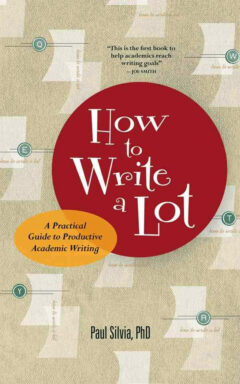
How to Write a Lot
By Paul J. Silvia. Washington, D.C.: American Psychological Association, 2007. 149 pages. ISBN: 978-1-59147-743-3.
If someone told me they had just read Paul J. Silvia’s How to Write a Lot and now were doing just that, I would scoff. I don’t need some book to tell me that writing according to a schedule is better than “binge writing.” But I do.
Silvia’s short book primarily is aimed at psychologists who engage in academic writing, preparing journal articles, review articles, and books. However, it is worth reading for any professor regardless of discipline. Just substitute “psychology” for whatever it is you do. The book also may help non-academic writers.
The author’s main point is that keeping to a writing schedule is the path to greater output. Of course, we know that. How many interviews have we read with successful novelists who describe their daily routine of writing? Plenty. (Here’s a recent overview of some.) Silvia correctly points to all those academics with research notes and unfinished manuscripts stored in filing cabinets who could be turning those stalled efforts into published pieces if they would just stick to a writing schedule.
So, if we know that, why aren’t we all doing so? Silvia offers several “specious barriers,” a few of which I am guilty. “Writing is a grim business, much like repairing a sewer or running a mortuary,” Silvia observes. We find various excuses to avoid writing. Perhaps the most difficult to avoid is the one about finding time to write. Silvia’s answer: “Instead of finding time, allot time to write.” Looking for time to write leads to binge writing, which occurs when we finally have locked on to a large block of hours or days, such as spring recess or summer vacation, to get work done. But that usually ends badly. Allotting time is sound advice for writers, and it’s what we have heard about other endeavors, such as exercising.
Beyond identifying a schedule as the key to writing a lot, Silvia suggests ways to motivate writing, discusses a number of stylistic points, and breaks down the process of writing journal articles and books. I liked his suggestion of creating a chart to track progress toward completing a book. It’s a good tool for any writing project and forces one to think seriously about outlining and the creative process.
A very useful part of the book is “Good Books About Writing,” a three-page appendix of largely familiar titles, but a few new ones to consider. I do wish Silvia had annotated the list, telling the reader why he thinks these books are good.
At one point, I began to wonder about the efficacy of reading Silvia’s book. If I already know most of everything he suggests, why am I reading it? Is reading about writing just another “specious barrier”? Perhaps, but it’s also the kick in the pants that I needed just now.
Accessed on 20 Apr 2024.
The article may be found online at https://straumanis.com/2018/how-to-write-lots/.
